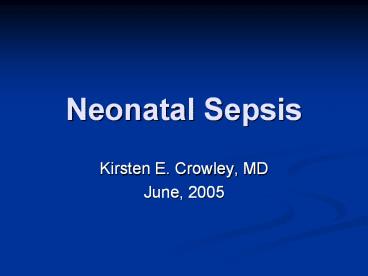Neonatal Sepsis PowerPoint PPT Presentation
1 / 18
Title: Neonatal Sepsis
1
Neonatal Sepsis
- Kirsten E. Crowley, MD
- June, 2005
2
Definition Incidence
- Clinical syndrome of systemic illness accompanied
by bacteremia occurring in the first month of
life - Incidence
- 1-8/1000 live births
- 13-27/1000 live births for infants lt 1500g
- Mortality rate is 13-25
- Higher rates in premature infants and those with
early fulminant disease
3
Early Onset
- First 5-7 days of life
- Usually multisystem fulminant illness with
prominent respiratory symptoms (probably due to
aspiration of infected amniotic fluid) - High mortality rate
- 5-20
- Typically acquired during intrapartum period from
maternal genital tract - Associated with maternal chorioamnionitis
4
Late Onset
- May occur as early as 5 days but is most common
after the first week of life - Less association with obstetric complications
- Usually have an identifiable focus
- Most often meningitis or sepsis
- Acquired from maternal genital tract or human
contact
5
Nosocomial sepsis
- Occurs in high-risk newborns
- Pathogenesis is related to
- the underlying illness of the infant
- the flora in the NICU environment
- invasive monitoring
- Breaks in the barrier function of the skin and
intestine allow for opportunistic infection
6
Causative organisms
- Primary sepsis
- Group B streptococcus
- Gram-negative enterics (esp. E. coli)
- Listeria monocytogenes, Staphylococcus, other
streptococci (entercocci), anaerobes, H. flu - Nosocomial sepsis
- Varies by nursery
- Staphylococcus epidermidis, Pseudomonas,
Klebsiella, Serratia, Proteus, and yeast are most
common
7
Risk factors
- Prematurity and low birth weight
- Premature and prolonged rupture of membranes
- Maternal peripartum fever
- Amniotic fluid problems (i.e. mec, chorio)
- Resuscitation at birth, fetal distress
- Multiple gestation
- Invasive procedures
- Galactosemia
- Other factors sex, race, variations in immune
function, hand washing in the NICU
8
Clinical presentation
- Clinical signs and symptoms are nonspecific
- Differential diagnosis
- RDS
- Metabolic disease
- Hematologic disease
- CNS disease
- Cardiac disease
- Other infectious processes (i.e. TORCH)
9
Clinical presentation
- Temperature irregularity (high or low)
- Change in behavior
- Lethargy, irritability, changes in tone
- Skin changes
- Poor perfusion, mottling, cyanosis, pallor,
petechiae, rashes, jaundice - Feeding problems
- Intolerance, vomiting, diarrhea, abdominal
distension - Cardiopulmonary
- Tachypnea, grunting, flaring, retractions, apnea,
tachycardia, hypotension - Metabolic
- Hypo or hyperglycemia, metabolic acidosis
10
Diagnosis
- Cultures
- Blood
- Confirms sepsis
- 94 grow by 48 hours of age
- Urine
- Dont need in infants lt24 hours old because UTIs
are exceedingly rare in this age group - CSF
- Controversial
- May be useful in clinically ill newborns or those
with positive blood cultures
11
Adjunctive lab tests
- White blood cell count and differential
- Neutropenia can be an ominous sign
- IT ratio gt 0.2 is of good predictive value
- Serial values can establish a trend
- Platelet count
- Late sign and very nonspecific
- Acute phase reactants
- CRP rises early, monitor serial values
- ESR rises late
- Other tests bilirubin, glucose, sodium
12
Radiology
- CXR
- Obtain in infants with respiratory symptoms
- Difficult to distinguish GBS or Listeria
pneumonia from uncomplicated RDS - Renal ultrasound and/or VCUG in infants with
accompanying UTI
13
RDS vs. GBS pneumonia???
14
Maternal studies
- Examination of the placenta and fetal membranes
for evidence of chorioamnionitis
15
Management
- Antibiotics
- Primary sepsis ampicillin and gentamicin
- Nosocomial sepsis vancomycin and gentamicin or
cefotaxime - Change based on culture sensitivities
- Dont forget to check levels
16
Supportive therapy
- Respiratory
- Oxygen and ventilation as necessary
- Cardiovascular
- Support blood pressure with volume expanders
and/or pressors - Hematologic
- Treat DIC with FFP and/or cryo
- CNS
- Treat seizures with phenobarbital
- Watch for signs of SIADH (decreased UOP,
hyponatremia) and treat with fluid restriction - Metabolic
- Treat hypoglycemia/hyperglycemia and metabolic
acidosis
17
GBS Prophylaxis
- GBS is the most common cause of early-onset
sepsis - 0.8-5.5/1000 live births
- Fatality rate of 5-15
- 10-30 of women are colonized in the vaginal and
rectal areas - Most mothers are screened at 35-37 weeks gestation
18
(No Transcript)

